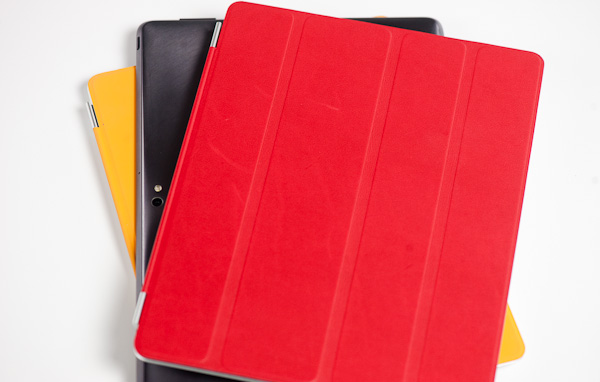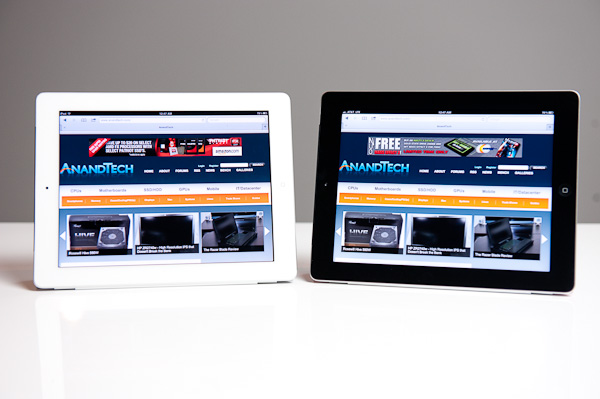The Apple iPad Review (2012)
by Vivek Gowri & Anand Lal Shimpi on March 28, 2012 3:14 PM ESTSince Apple launched the first iPad two years ago, the tablet market has evolved rapidly. While slate tablets were nothing new, the original iPad was the first serious tablet to be built around smartphone components and a user interface designed specifically for touchscreen input. The hardware was enough to run the OS smoothly while maintaining good battery life, the thin and light form factor lent itself to easy portability, and the touch-based user experience was miles better than earlier devices based on desktop operating systems.
We take it for granted now, but this was all news back in 2010, and the iPad was practically in a category of its own, with no real competitors to speak of. After Apple started shipping the iPad, the segment basically exploded—we had Google jump in with Honeycomb, HP got into it (and then out of it) with webOS, RIM had a go with the PlayBook, Amazon pushed the Kindle line into the tablet space, and Microsoft created its next release of Windows with tablets in mind. Along the way, Apple updated the iPad, both on the software side with multitasking, a new notifications system, and a myriad of UI updates, as well as launching second generation iPad hardware. The iPad 2 was a comprehensive update, bringing a dual core processor, unrivaled graphics performance, cameras fore and aft, and a ground up redesign that brought a thinner and lighter form factor.
The iPad 2 was a significant improvement over the original—faster, more portable, and generally a far more polished device. Not that it was perfect: iOS 4 still had issues with smooth multitasking and an archaic notifications system, the cameras were mediocre, and the XGA display, while a great quality panel, didn’t have the kind of pixel density expected of a premium mobile device. The iPad 2 hit market around the same time as Honeycomb (in Motorola’s Xoom) early last year, and at first Apple still held a major edge in terms of hardware. As more impressive Honeycomb devices like Samsung’s Galaxy Tab 10.1 and the ASUS Transformer Prime were launched, along with Ice Cream Sandwich looming on the horizon, Android became a much more viable tablet alternative to iOS. And with Microsoft planning for a major push later this year for ARM-based Windows 8 tablets centered around the Metro UI, Apple has never faced such stiff competition in the tablet space. Which brings us to the third generation of iPad hardware.
It has a display resolution that dwarfs most high-end desktop displays. The panel also puts a real emphasis on quality, not just resolution. For a computing device targeted squarely at the consumer market, both of these things are rarities.
Its SoC is the absolute largest ever squeezed into an ARM based tablet. The chip itself is even bigger than what you find in most mainstream notebooks. It’s expensive, it puts out a ton of heat and it offers a tremendous GPU performance advantage over anything else in its class.
And it has a battery that’s larger than what ships in the current crop of similarly sized ultraportables and Ultrabooks.
The new iPad doesn’t significantly change the tablet usage paradigm, but it does put all previous attempts at building hardware in this space to shame. It’s the sort of no holds barred, performance at any expense design that we’re used to seeing from enthusiast PC component vendors—but in a tablet...from Apple.
Welcome to the new iPad.












234 Comments
View All Comments
BSMonitor - Thursday, March 29, 2012 - link
Common might have been the wrong word. But for the masses of users(mostly consumer space), internet browsing is probably the most frequent task. But overall time spent on the devices, I would guess movies/videos are #1.mavere - Wednesday, March 28, 2012 - link
The iPad's h.264 decoder has always been especially efficient.If Apple's battery life claim is 10 hours, I'd expect 11-12 hours non-streaming video playback.
Openmindeo - Wednesday, March 28, 2012 - link
In the second page it says that the ipad 1 has a memory of 256GB .The entire article was fine.
Regards.
Anand Lal Shimpi - Wednesday, March 28, 2012 - link
Thanks for the correction!Take care,
Anand
isoJ - Wednesday, March 28, 2012 - link
Good points about the future and a clear demand for low-power bandwidth. Isn't PS Vita already shipping with Wide-IO?BSMonitor - Wednesday, March 28, 2012 - link
I only have an iphone so I have not played around with the home sharing and all that in iTunes.Can they communicate locally via WiFi for Movies, Music, etc(without a PC or iCloud)?? My impression is that they must be connected to iTunes or iCloud to access/transfer media content.
i.e. I have a 64GB iPhone 4, and load it with 20 movies and GB's of music. And say a 16GB iPad. Can I transfer a movie from the iPhone to iPad with it going to the PC/Mac or iCloud first?
darkcrayon - Wednesday, March 28, 2012 - link
You can transfer movies if you have a movie player app that supports it, several apps support file transfers over wifi (for example GoodReader can copy any of its files to GoodReader running on another device). You could use GoodReader and similar apps instead of Music to play songs, though it's not as well integrated into the OS (but songs will still play and switch in the background, etc).You can not transfer things you've previously loaded into the Music or Videos (ie the built in "Apple apps") between two iPads though.
BSMonitor - Thursday, March 29, 2012 - link
Thanks. I figured as much.ltcommanderdata - Wednesday, March 28, 2012 - link
On page 11 you say:"Perhaps this is why Apple forbids the application from running on a first generation iPad, with only one CPU core."
I don't think the single CPU core is the primary reason why iPhoto isn't supported on the first gen iPad. Afterall, the same single core A4 iPhone 4 support iPhoto. What's more, the iPhone 4's A4 is clocked lower than the first gen iPad so CPU performance isn't the primary reason. RAM appears to be the main concern with iPhoto since every supported device has at least 512MB of RAM.
Anand Lal Shimpi - Wednesday, March 28, 2012 - link
Very good point, updated :)Take care,
Anand